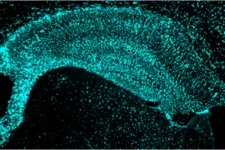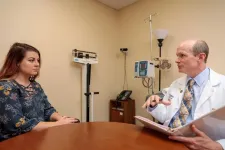(Press-News.org) In counties with already high COVID-19 infection rates, birthday bashes may have fueled infection spread during the peak months of the pandemic, according to a new analysis led by researchers at Harvard Medical School and the RAND Corporation.
The report, published June 21 in JAMA Internal Medicine, shows that in counties with high rates of COVID-19, households with recent birthdays were 30 percent more likely to have a COVID-19 diagnosis, compared with households with no birthdays. The analysis is based on data from health insurance claims.
The researchers point out that they did not count actual birthday parties in their analysis. Instead, they used birth dates of household members as a proxy for social gatherings and in-person festivities.
Nonetheless, the team said, the findings do signal that social gatherings, such as birthday parties, may have contributed to infections during the height of the pandemic.
"These gatherings are an important part of the social fabric that holds together families and society as a whole. However, as we show, in high-risk areas, they can also expose households to COVID-19 infections," said study senior author Anupam Jena, the Ruth L. Newhouse Associate Professor of Health Care Policy at HMS.
With growing vaccination rates and infections dropping in many areas of the country, such hindsight analysis may seem outdated, but the findings hold important clues for public health officials and individuals should another surge occur, the scientists said.
"Our results could help inform future measures," Jena said. "They do underscore the importance of understanding the types of activities that may worsen viral spread during a pandemic and can inform policy and individual decisions based on risk. The findings also quantify the potential risk of gathering with people that we know."
For more than a year starting in early 2020, across much of the United States, many schools were closed for in-person learning, large segments of the population worked from home, and many forms of large and formal gatherings were strictly limited, including sporting events, concerts, and funerals. In spite of these restrictions, aimed at reducing the kind of social interactions that fuel an infectious outbreak, the nation has seen more than 32 million confirmed cases of COVID-19 and nearly 600,000 deaths.
Experts have speculated that small and informal gatherings might have played an important role in the spread of the virus, but the degree of risk associated with various kinds of social activities has been hard to measure, or even estimate. In the absence of massive contact tracing and widespread diagnostic testing, it would be extremely challenging to find data tying new infections to most kinds of informal gatherings, the researchers said.
To get around those obstacles, Jena and colleagues tried to tease out the relationship between social gatherings and COVID-19 by studying whether infection rates increase in households in which a member recently had a birthday, because these occasions are often celebrated with some kind of get-together, and birth dates are embedded in medical records and insurance databases along with COVID-19 diagnoses.
The researchers analyzed a nationwide sample of nearly 3 million U.S. households with employer-based insurance provided by Castlight Health. Over the first 45 weeks of 2020 the researchers found that in counties with high COVID-19 transmission, households with recent birthdays averaged 8.6 more cases per 10,000 individuals than households in the same counties without a birthday.
The magnitude of the risk varied based on the age of the person with a birthday. In households in which a child had a birthday, the effect was even higher, with an increase in COVID-19 cases of 15.8 per 10,000 persons in the two weeks following a child's birthday compared to cases in families without a birthday. In households with an adult birthday, the increase was 5.8 additional cases per 10,000. The researchers speculated that households with child birthdays might have been less likely to cancel birthday plans due to the pandemic, or that social distancing may have been followed less strictly at children's birthday parties.
Among households in counties with low COVID-19 prevalence, the study did not find any increased rate of infection in the weeks following birthdays. The researchers also did not find that the overall link between birthdays and COVID-19 differed based on the political leanings of the household's county, or on other factors like whether it rained during the week of the birthday--which might have driven celebrations indoors--or whether a shelter-in-place policy was in effect in the household's county at the time of the birthday.
"We were only able to examine a single kind of event that likely leads to social gatherings, but given the magnitude of the increased risk associated with having a birthday in the household, it's clear that informal gatherings of all kinds played a significant role in the spread of COVID-19," said study co-author Christopher Whaley of the RAND Corporation.
INFORMATION:
Study: JAMA Intern Med. doi:10.1001/jamainternmed.2021.2915 (link will go live at 11 a.m. ET on Monday, June 21)
Support for the research was provided by grant 1K01AG061274 from the National Institute on Aging.
Disclosures: Whaley reported receiving consulting fees from Doximity outside the submitted work. Jena reported receiving personal fees from Pfizer, Bioverativ, Bristol Myers Squibb, Merck, Janssen, Edwards Lifesciences, Novartis, Amgen, Eli Lilly, Vertex, AstraZeneca, Celgene, Tesaro, Sanofi Aventis, Precision Health Economics, and Analysis Group outside the submitted work. No other disclosures were reported.
A computerized brain implant effectively relieves short-term and chronic pain in rodents, a new study finds.
The experiments, conducted by investigators at NYU Grossman School of Medicine, offer what the researchers call a "blueprint" for the development of brain implants to treat pain syndromes and other brain-based disorders, such as anxiety, depression, and panic attacks.
Publishing June 21 in the journal Nature Biomedical Engineering, the study showed that device-implanted rats withdrew their paws 40 percent more slowly from sudden pain compared with times when their device was turned off.
According to the study authors, this suggests that the device reduced ...
Engineers at Tufts University have developed new methods to more efficiently fabricate materials that behave in unusual ways when interacting with microwave energy, with potential implications for telecommunications, GPS, radar, mobile devices, and medical devices. Known as metamaterials, they are sometimes referred to as "impossible materials" because they could, in theory, bend energy around objects to make them appear invisible, concentrate the transmission of energy into focused beams, or have chameleon like abilities to reconfigure their absorption or transmission of different frequency ranges.
The innovation, described today in Nature Electronics, constructs the metamaterials using ...
CAMBRIDGE, MA -- Every year, about 400,000 people receive silicone breast implants in the United States. According to data from the U.S. Food and Drug Administration, a majority of those implants needs to be replaced within 10 years due to the buildup of scar tissue and other complications.
A team led by MIT researchers has now systematically analyzed how the varying surface architecture found in these implants influences the development of adverse effects, which in rare cases can include an unusual type of lymphoma.
"The surface topography of an implant can drastically affect how the immune response perceives it, and this has important ramifications for the [implants'] design," says Omid Veiseh, a former MIT postdoc. "We ...
Researchers at the University of Bristol have discovered a method which will allow for faster communication systems and better energy saving electronics.
The breakthrough was made by establishing how to remotely measure the electric field inside a semiconductor device for the first time. A semiconductor is a material, such as Silicon, which can be used in electronic devices to control electric current.
Now, in this new study, published today in Nature Electronics, scientists outline how to precisely quantify this electric field, meaning next generation power and radio frequency electronic devices can be developed which have the potential to be faster, and more reliable, as well as more energy ...
A process using a light-sensitive chemical can drastically reduce cost and energy consumption to produce gamma-cyclodextrin, a compound that is widely used in manufacturing, according to a Dartmouth study.
The research, published in Chem, demonstrates how a hydrazone template can replace energy-intensive distillation to produce and isolate gamma-cyclodextrin--a water-soluble chemical that attracts other molecules and is used to enhance food, pharmaceuticals, and a wide range of consumer products.
"These compounds are biodegradable, biocompatible, benign and commonly used," said Ivan Aprahamian, a professor of chemistry at Dartmouth. "We are making ...
By the time people with Alzheimer's disease start exhibiting difficulty remembering and thinking, the disease has been developing in their brains for two decades or more, and their brain tissue already has sustained damage. As the disease progresses, the damage accumulates, and their symptoms worsen.
Researchers at Washington University School of Medicine in St. Louis have found that high levels of a normal protein associated with reduced heart disease also protect against Alzheimer's-like brain damage - at least in mice. The findings, published June 21 in Neuron, suggest that raising levels ...
An investigational Alzheimer's drug reduced molecular markers of disease and curbed neurodegeneration in the brain, without demonstrating evidence of cognitive benefit, in a phase 2/3 clinical trial led by researchers at Washington University School of Medicine in St. Louis through its Dominantly Inherited Alzheimer Network-Trials Unit (DIAN-TU). These results led the trial leaders to offer the drug, known as gantenerumab, to participants as part of an exploratory open-label extension. The researchers continue to monitor changes in measures of Alzheimer's disease in those participants who are receiving the drug.
The DIAN-TU study (ClinicalTrials.gov Identifier: NCT01760005), published June 21 in Nature Medicine, evaluated the effects of two investigational drugs - ...
In the mid-2030s, multiple United States coastal regions may see rapid increases in the number of high-tide flooding (HTF) days, according to a study led by the University of Hawai'i at Mānoa and published today in Nature Climate Change. The combined effects of sea-level rise (SLR) and natural fluctuations in tidal range are anticipated to cause tipping points in the frequency of HTF.
Coastal locations around the U.S., particularly along the Atlantic coast, are experiencing recurrent flooding at high tide. The impact of HTF accumulates over numerous seemingly minor occurrences, which can exceed the impact of rare extremes over time. These impacts are subtle--for example, the loss of revenue due to recurrent road and business closures--compared with the physical damage of property ...
Scientists studying a common childhood cancer have made a major breakthrough which could lead to a cure for some youngsters who would not have survived the condition.
An international study, involving Newcastle University, UK, has for the first time found a genetic marker in tumours from patients with high-risk neuroblastoma.
Research, published in the Journal of Clinical Oncology, has identified that alterations in the neuroblastoma's ALK (anaplastic lymphoma kinase) gene are associated with a significantly poorer prognosis for children with high-risk disease.
Experts ...
Drugs routinely used during fertility treatments to release eggs do not increase the risk of developing breast cancer, new research has shown.
Researchers from King's College London, in partnership with King's Fertility, analysed studies involving 1.8 million women undergoing fertility treatments. These women were followed up in studies for an average period of 27 years and had no increase in the risk of developing breast cancer.
The research, published today in Fertility and Sterility journal, is the largest study to date assessing whether commonly used fertility drugs are for a cancer risk for women.
Fertility treatments can range from using medications to boost the release of an egg in a women's natural cycle to more complex ...





